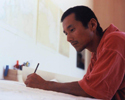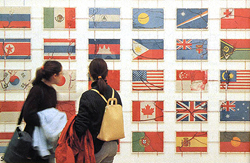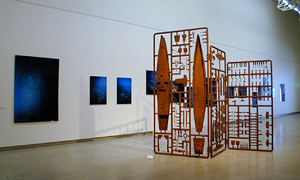Yukinori Yanagi (artist, Born 1959, in Fukoka prefecture, living in Hiroshima)
Okabe: You were living in America for quite a long time, right?

©Yukinori Yanagi
Yanagi: Yes, I had been working as an artist for about three years in Japan after I finished the graduate course of Musashino Art University. However, I felt stuck to keep on as an artist so I went abroad to study at the graduate course of Yale University.
Okabe: That’s amazing. I don’t think there are so many artists that graduated Yale.
Yanagi: If you look for other Japanese artists, Ritsuko Taho, who now teaches at the Department of Intermedia Art of Tokyo University of the Arts, is also one of the graduates of Yale. The sculpture program that I studied had good working space and scholarship but they also had a problem. Although they had the whole building for sculpture’s studio, the building was located next to the slums. I had my computer stolen twice in my office.
Okabe: But you were interested in such places like the slums, no?
Yanagi: Such situation really made me think deeply. I experienced the specific gaze and feelings that comes from the difference of the color of the skin.
Okabe: Had you stayed abroad before that?
Yanagi: We didn’t have as many chances as nowadays to go abroad. The only information we had was from Tadashi Kawamata who aggressively went abroad and found out about stuffs like P.S.1. There was no way of knowing about artist-in-residence in foreign countries. So I went to Yale University that I happened to know.
Okabe: I suppose you earned a lot during your two years abroad.
Yanagi: Yes, I believe it was better than to have stayed in Japan. America was totally a competitive society. And it was surprising to see the students treated equally to the teachers. They even had the same vote to decide the next graduate student. We had “Crit” (critique) in turn every week and went through thorough discussion. There were about ten members in the beginning but since the class was so hard, some people dropped out and about six people were left in the end.
Okabe: And you were still there despite the tough classes and your poor English.
Yanagi: I had no choice but to compete with the artwork itself. So conversely, I was able to concentrate on creating artworks. By creating works with universal theme as possible, I trained myself to make people understand the concept by just looking at the work. I also groped for the way to communicate with simple words.
Okabe: Although NYU (New York University) has courses to become an artist too, Yale ranks with the best and the graduates get more attention than the others. Columbia University has quite good courses too and NYU is getting better recently.
Yanagi: I suppose each university has it’s own streak, but it’s true that Yale produces good artists constantly. Ann Hamilton is my senior and Mathew Barney and I were in Yale during the same time. So now that I think back, there were talented people around.
Okabe: After that, you’ve been going back and forth between Japan and America, right?
Yanagi: I returned to Japan to obtain a visa and after that, I went to P.S.1 with the support of ACC. I then got my own studio and stayed abroad for eight years in total. I took a green card but it has been automatically cancelled and vanished now. I was getting fed up just before the 9.11 and returned to Japan just before it.
Okabe: You lived in New York in the 90’s.


Hinomaru Illumination Fuji Television Gallery, Tokyo, 1992
Chrysanthemum Carpet Art Tower Mito, Mito Annual’94
©Yukinori Yanagi
Yanagi: America was in a recession when I went there. But a little after that, the market started to become active. Just like how SOHO suddenly became crowded. The Chelsea area near my studio also changed very much. It became such a contradictory situation that artists were forced to move out because the number of art galleries had increased. It seemed that the criterion of artists had shifted to how much an artist can sell his or her work for, in other words commercialism, so I couldn’t stand living there anymore. Japan has a similar tendency these days. Having seen such a situation, I wanted to do something locally in my country.
Okabe: I understand very well. Your works have strong political aspects and since it criticizes and resists against commercialism and capitalism, it might be hard to be accepted in America, where those are so strong.
Yanagi: That’s true. Once when I held an exhibition in the Midwest, some veterans surrounded the museum and demanded that the exhibition be canceled. That was when I exhibited a work that showed ants eating up the Stars and Stripes. Well, no wonder it caused a problem. Also when I was lecturing on a project about atomic bomb in New York, a veteran came in and the talk shifted to whether it was right or wrong to drop the atomic bomb. It was impossible to talk about art. I also had a similar experience in South Korea. Since the Japanese culture wasn’t so much accepted as it is nowadays, I was noticed by the authorities and was deported. That was about a work dealing with the flags of North and South Korea.

Pacific, Landscape Encoded in Tate Modern London 2000 ©Yukinori Yanagi
Okabe: You seem to have gone through tough experience. It’s hard to believe such times existed, but I suppose it was because of such times that you made radical works. I think you would’ve made something more different if it were now. You were aware of being in trouble, weren’t you?
Yanagi: I can’t predict troubles. Nothing went wrong when I did something that the others got cold feet and stopped me. But I was in big trouble when I supposed I wouldn’t be. I just have to face it.
Okabe: You’re basically interested in changing the space. Inujima was a project to change a certain spot and now you’re working on another art project at places you can change in Hiroshima and trying to spread the change throughout the city.
Yanagi: I believe in the power of art honestly. Or rather, I can’t do anything without believing it. In the case of Inujima, I tried to solve the problems of industrial waste and depopulation somehow. There are other means for big cities like Hiroshima since even the useless factories in the city can become a cultural resource if used well.
Okabe: Just like Tate Modern.
Yanagi: Maybe not that big, but I’m sure art can be effective in these kinds of issues. So I’d like to suggest more ways by myself. I’m now interested in leading or organizing a project that involves many people rather than exhibiting my works egoistically.

Akitsushima 50-I, Hiroshima City Museum of Contemporary Art, 2000 ©Yukinori Yanagi
(At Division of Contemporary Art and Theory, Faculty of Art, Hiroshima City University, August 8th ,2007, translated by Akihiko Sugiura)
柳幸典 (アーティスト、1959年福岡生まれ、広島在住)
岡部あおみ:柳さんはアメリカに比較的長くいらっしゃったのですよね。
柳幸典:そうですね。武蔵野美術大学の大学院を卒業してから3 年ほど日本で作家活動をしていたのですが、そのまま続けていくことに限界 を感じて、イエール大学の大学院に留学しました。
岡部:すごいですね。芸術家でイエール大学の大学院を出た人はあまりいないでしょう。
柳:日本人のアーティストだと、芸大の先端にいらっしゃるたほりつこさんも卒業生なんです。
僕が行ったイエールの彫刻科は、奨学金と作 業スペースが充実していましたが、問題もありました。大きな建物一つが丸ごと彫刻科のスタジオなんですけど、その隣はスラム街だったんです。僕の事務所で も、2度コンピューターを盗られてしまいました。
岡部:でも、柳さんはスラムなどの場所にも興味があったのでしょう?(笑)
柳:そういう現場を見られたのはすごく考えさせられましたね。皮膚の色の違いからくる独特の視線や、感覚を体験することができました。
岡部:それ以前は、海外に滞在したご経験はなかったのでしょうか。
柳:今ほど海外に出れるチャンスもなかったですし。唯一、川俣正さんがどんどん切り込んでいって、P.S.1 とかの情報を得られるくらいでしたね。まして、当時は海外でのアーティスト・イン・レジデンスなんて情報は知らないですからね。それで、たまたま知っていたイエールに行ったんです。
岡部:二年間の留学で得るものは大きかったでしょうね。
柳:そうですね、あのまま日本にいるよりは良かったと思います。徹底的にコンペティションの社会です。それとびっくりしたのが、教員も学生も同じテーブルでフェアなことです。次の大学院生を選ぶのも、同じ一票なんです。最初は10 人ぐらいいるんですけど、毎週のように順番に「クリット」(講評)があって、徹底的にやりあうし、厳しいからやめていって、最終的には6 人ぐらいになりましたね。
岡部:そんな過酷なプロセスでも、英語ができなくても、柳さんは残ったわけですね(笑)。
柳:作品で勝負するしかなかったのですよ、だから、逆に作品に特化できたと思います。ハンディを克服するために、作品ではできるだけ普 遍的なテーマを扱って、作品だけでもわかってもらえるように修業しました。あとは、シンプルな言語でいかにコミュニケーションするかということも。
岡部::NYU(ニューヨーク大学)にもアーティストになるコースがありますけど、イエールはトップレベルで、イエール出身というだけで注目度が違うといった学閥もありますよね。コロンビアも割と良くて、NYU は最近良くなってきたと言われています。
柳:大学にも波がありますが、確かにイエールはコンスタントに良い作家が出て来ています。僕の上の方にはアン・ハミルトンがいたし、僕と同じ時ならマシュー・バーニーもいて、今から思えば充実していました。
岡部:そのあとは、アメリカと日本を行ったり来たりなさっていたのでしょう?
柳:一度帰国してビザを取り直してから、ACC の助成でP.S.1 に行ったんです。そこで、そのままスタジオを構えて、トータルで8 年向こうに。グリーンカードも取りましたが、今はもう自動的にキャンセルされて、消滅しちゃいました(笑)。もう嫌だなあと、9.11 のちょうど直前あたりに思っていて、本当にあの直前に帰国した感じですね。
岡部:90 年代のニューヨークで生活されていたのですね。
柳:僕が行った頃がアメリカでは不況で、それから徐々にマーケットが加熱していったんです。
SOHO なんか閑散としていたのが、急に。 僕がスタジオを持っていた近くのチェルシーエリアもすごく変わりました。画廊がたくさんできたために、アーティストが追い出されてしまうという、矛盾した状況になってしまったんです。商業至上主義というか、アーティストの評価基準がいかに作品が高く売れるかにシフトしてしまった気がして、とても住んでいられないと思いました。今、日本もそういう傾向にありますよね。そういう状況を見ていて、自分の国でしっかり地に足を付けたことしたいなと思って。
岡部:とてもよくわかります。柳さんの作品にはポリティカルな面が強いので、商業至上主義、資本原理主義が強い米国で、それに対して反抗したり批判をする作品は、受け入れられるのが難しいのではないでしょうか。
柳:もちろん受け入れられないですよ。中西部で開催された僕の展覧会で、退役軍人に美術館を取り囲まれて、キャンセルしろって言われたこともあったし。それは、まさしく星条旗をアリが食いつぶしている作品で、そりゃあ大変なことになりますよね。それからニューヨークでも、原爆をテーマに したプロジェクトのレクチャーの時に、退役軍人の人が来て、原爆を落としたのは正当か正当じゃなかったのかということに話がシフトしてしまい、とてもアートの話はできませんでした。アメリカだけじゃなく、韓国でもそういう経験があった。日本の文化が今のようにこれほど受け入れられる前だったので、展覧会の前に当局に察知され、強制送還された(笑)。それは南北朝鮮の旗の作品なんですけど。
岡部:ずいぶん大変な思いをなさって来ているんですね。今だったら考えられないでしょうが、でもそういう時期だからこそ、そうしたラディカルな作品を作ろうと思ったんのではないですか?今のような時代だったら、おそらく違う作品を作っていたようにも思います。問題が起きるのは覚悟の上だったでしょう。
柳:周りはビビってやめろっていうんだけど、やってみたら何でもなかったり。逆に、こんな事何でもないだろうと思ったら、大問題になったり。これはどうしようもないです。
岡部:柳さんがやりたいと思っていることは、基本的には場を変えることですよね。犬島という一つの場を変えるプロジェクトから、今は、広島の中の変えられる場所でアートプロジェクトを行い、都市全体の変化へと広げてゆきたいといった形で。
柳:僕の場合は愚直にアートのパワーを信じているところがあって。というか、信じていないとやっていられません。例えば犬島であったら、産業廃棄物問題や過疎の問題を何とか解決できないかと思ったし、広島のように大都市の場合は切り口が違って、都市の使われなくなった工場も、有効に使えば文化的に資源なわけですから。
岡部:テートモダンみたいに。(笑)
柳:あんな大きなスケールではないにしても、やれると思うんです。そういうところでアートの力が発揮できると信じているので、自分がこれから提案していきたい。今は、エゴイスティックに自分の作品を発表したり、表現することには興味がなくて、力を結集して行うプロジェクト、その統率やオーガナイズをしてみたいんです。
(2007年8月8日 広島市立大学芸術学部現代表現領域研究室にて、編集:原田 裕規)
